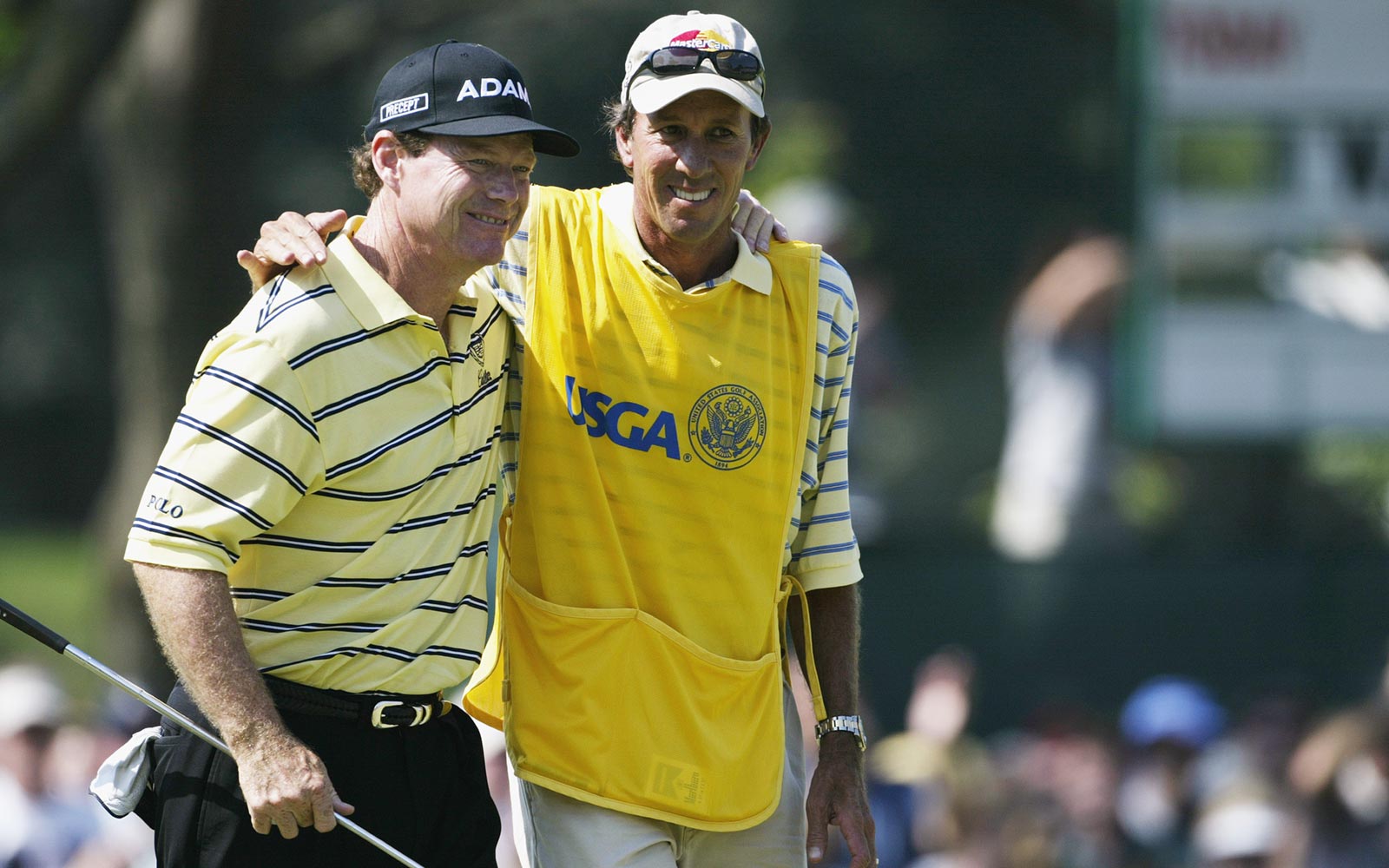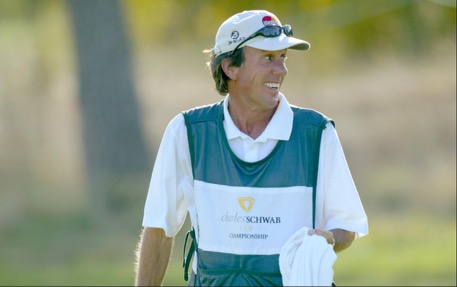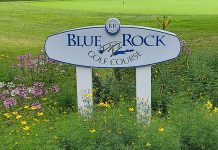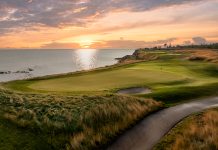Players making millions of dollars for themselves and hundreds of local charities garner most of the attention in professional golf, but less conspicuous people also pay and provide plenty of input to the success of tournaments, especially on the PGA Tour.
Two such individuals, Andy Bessette and the late Bruce Edwards, will be recognized for their contributions to the game when they are inducted into the Connecticut Golf Hall of Fame at the Hartford Downtown Marriott on June 20, the start of Travelers Championship week at TPC River Highlands in Cromwell.
Bessette, the executive vice president and chief administrative officer of The Travelers Companies, Inc., is the only PGA Tour title sponsor leader to travel to tournaments and walk the practice range to try to help land the best players in the world and ask how things can be improved. He is joined by tournament director Nathan Grube, who is more than delighted to have a major league support system for the biggest sporting event in Connecticut.

“It is an absolute team effort between tournament and title sponsor regarding player relationships that we have established over the last 16-plus years,” Grube said. “But we simply would not have the players we have each year without Andy.”
Bessette and Grube go to a handful of events a year that epitomizes the Travelers exec’s guiding business principle.
“Every year our motto, and I’ve always had this motto throughout my whole life, is that the status quo is unacceptable,” Bessette said. “You have to always get better. If you’re not better tomorrow than you are today than you’re going backwards.”
The 67-year-old Bessette specializes in his credo while getting to know more and more people every year, starting in 2006, when he and Grube began meeting and building relationships with players, their families, caddies, media members and many others.
“We talked to everybody,” Bessette said. “We asked (Fairfield native) J.J. Henry, who was the defending champion, and Bubba Watson, ‘What’s important to you guys? We want to have the best tournament on the PGA Tour.’ They were shocked we even asked the question. We asked (then-ESPN personality) Mike Tirico, ‘What do we have to do?’ And we continue to do that every year. A couple years ago I saw Ted Scott, who was Bubba’s caddie at the time, and I asked him, ‘What can we do to keep making this tournament better?’ He said, ‘Are you kidding me? You already do everything.’
“We’ll never stop. We will always ask what can we do better, how can we be greater, how can we attract the best players in the world.”
Bessette’s efforts have helped lift the tournament to one of the best attended in the world attracting solid player fields and have raised more than $45.5 million for local charities, including $22.5 million since the insurance magnet became title sponsor, capped by $2.2 million in 2021.
“I’m very appreciative and proud but also a little embarrassed,” Bessette said of his induction. “This recognition represents all of the work that our teams – Nathan’s team at the Travelers Championship and my team at Travelers – have done throughout the years to build a world-class event. I can name everyone in our groups who have helped take this tournament to where it is. I’m really humbled, but it’s not just me. Only a great team can make this work.”
Bessette said he has a special feeling about being inducted with Edwards.
“I look at the relationship Bruce had with Tom Watson, caddie and player,” Bessette said. “They had a great partnership, experienced the highest highs golf can offer at the professional level, and I have the utmost respect for all they accomplished together. I’m honored that the Connecticut Golf Hall of Fame thinks that I would be at the same level. I find it humbling and surprising to be regarded in the same breath as Bruce Edwards.”
Golf hasn’t been the only notable sport for Bessette, who lives in West Hartford. He was an Olympic hammer thrower who earned a bachelor’s degree from the University of Connecticut in 1975 and then a master’s degree from the University of Rhode Island. He was a four-time Division I All-American as a hammer thrower and won the Olympic Trials in 1980, which put him on the U.S. OIympic team. Unfortunately, the United States did not participate in the 1980 Olympics in Moscow.
After graduating from UConn, Bessette was an economic geographer who helped companies determine the best locations to open offices. In 1977, he was hired by Sheraton and joined the Olympic Job Opportunities program to compete with the Soviet bloc of countries by working half a day and training during the other half. After Sheraton discontinued its program in 1980, Bessette joined Travelers, held several positions and then in 2006 worked with Travelers executive chairman of the board Jay Fishman to spearhead the company’s drive to move Travelers into the title sponsorship of a PGA Tour event. They have been instrumental in improving the event every year, and it has won 15 PGA Tour Best Of awards since 2009, capped in 2017 when it received Tournament of the Year, Most Fan Friendly Event, Best Tournament Sales and the inaugural Players Choice, a category voted on exclusively by PGA Tour players
In 2016, Travelers hosted the Bruce Edwards Foundation dinner to benefit ALS research after the second round of the tournament. It led to a record $2.8 million, and speakers included Fishman, Tom Watson, whom Edwards worked for for 30 years, PGA Tour commissioner Tim Finchem, CBS announcer Jim Nantz, then-Connecticut Governor Dannel Malloy and renowned biographer/dinner emcee John Feinstein. It drew more than 1,100 people, including dozens of players and caddies, raised $1.1 million and also honored Fishman, who died of ALS only 10 days after the tournament. Watson, a three-time tournament champion, donated $100,000, and Brian Gay contributed the $10,000 that he won during the tournament’s closest to the pin competition at The Umbrella at Hole 15 1/2.
Edwards, a Wethersfield native, was one of the leading PGA Tour caddies for more than three decades working for Hall of Famer Watson and 1995 Canon Greater Hartford Open champion Greg Norman before he died of ALS in 2004 at the age of 49. After graduating from Marianapolis Prep in Thompson in 1973, Edwards thought he’d try caddying at the highest level after he, brother Brian and several other local caddies had worked for various players during the Greater Hartford Open at Wethersfield Country Club. But what Edwards thought would be a one-year experiment became three decades of employment and travels around the globe. Edwards’ parents weren’t keen on the idea of the second of their four children becoming a caddie rather than a doctor or lawyer or dentist, like his dad, Jay, but after Bruce became arguably the most famous and inspirational caddie in golf history, they knew he had made the right decision.

Edwards’ parents and three siblings were especially proud of how Bruce handled his final months battling ALS before succumbing at only 49 at 6:26 a.m. on April 8, 2004, the morning of the start of his favorite tournament, the Masters. His death came only hours after his father accepted the Golf Writers Association of America’s Ben Hogan Award, given annually to an individual who continued to be active in golf despite a physical handicap or serious injury, on his son’s behalf at the organization’s annual awards dinner.
“Bruce truly loved what he was doing from his first day on Tour to the very end (in 2003),” said Jay Edwards, 92, a retired dentist now living in Vero Beach, Fla. “Thank God Bruce was always the kind of kid who stuck to his guns. Those first few years, we kept waiting for him to say ‘enough” and come home and go to college. Who knows, if he hadn’t ended up with Tom, maybe he would have come home, but I’m not sure.
“Bruce loved the life out there. He made lots of friends, good friends, and he really found a niche doing what he was doing. He was right, we were wrong. I’m really proud of what he became.”
No one was more of a friend to Edwards than Watson, an eight-time major championship winner who continues to raise funds to fight ASL. Watson once gave Bruce a new van as a Christmas present to help make travel on the PGA Tour more comfortable, but it was the support that Watson offered through Bruce’s final weeks that made their relationship so special. Despite learning of Bruce’s death only hours after it happened, Watson knew he had to play the first round of the Masters because that’s what his longtime caddie/friend would have wanted.
After his round, Watson emotionally talked about Bruce for an hour and pledged to do everything in his power “to kill this damn disease.”
“Bruce Edwards, my caddie and good friend, didn’t have a mean bone in his body,” Watson said. “He was respected, admired and loved by many. His glass was always half full, never half empty. He did his job right, with an enthusiasm that was infectious to a lot of other caddies who became the core looper group on the PGA Tour, many of whom came out of the Hartford area.
“We always laughed at the life we both led, gypsies following the dream, me playing the PGA Tour and him carrying my bag. And indeed what a great life we shared together.”
Edwards was 12 when he first caddied in the GHO, and his first job on the PGA Tour was for David Graham at the Kemper Open in Charlotte, N.C. He then was caddying across the country when he found himself outside the locker room at the St. Louis Children’s Hospital Golf Classic six weeks later. He saw “a long-haired golfer” in the parking lot and asked Watson if he could work for him. Tom said he could have a tryout for a week, and they would see what transpired.
Watson finished sixth and immediately took a liking to Edwards’ enthusiasm, work ethic and attention to detail and said they could continue to be a team. Their partnership lasted until 1989, and they won 35 PGA Tour events, though Bruce was on Tom’s bag for only one of his eight major championships due to caddie regulations. When Watson began to cut back his schedule, he encouraged Edwards to accept an offer from Norman, then the No. 1 ranked player in the world. Edwards worked for Norman for three years before returning to Watson in 1992, and the duo continued together again until Edwards was diagnosed with ALS during a visit to the Mayo Clinic in Rochester, Minn., and told he had one to three years to live.
Edwards spent much of his final 15 months doing interviews about what he was dealing with because it wasn’t in his nature to say no to people and to raise awareness about the disease. And, in doing so, he helped raise money for research, if not in time to save his life, then perhaps to save others. He did it all with a grace and courage that had made him into a heroic figure to many, not a role that Bruce wanted or felt he deserved. But he accepted it as part of what he was going through.
“A lot of people described the last few months as bittersweet for Bruce and me,” Watson said as the end neared. “I can honestly say it’s a lot more bitter than sweet. A lot more.”
Edwards’ younger sister, Gwyn Dieterle, 59, is a mother of three who works in marketing for AAA Northeast, lives in Franklin, Mass., and called her late brother “a free spirit.” She recalls him escaping from his bedroom window when grounded and having his hair long, smoking cigarettes and wearing classic 1970s clothes such as a leather, covered-in-fringe jacket.
“My parents were challenged by his rebellious spirit, my sister and he were as opposite as siblings can be and he and my brother shared a bedroom for a while that led to more than a few ‘disagreements,’ ” Gwyn recalled. “However, I thought Bruce was the coolest brother ever. He was self-assured — no one could pull off that fringed leather jacket like he could — witty and outgoing. When I attended tournaments in which he was caddying, be it the GHO, Westchester (N.Y) or Pleasant Valley (in Sutton, Mass.), he’d make it a point to come over to me and chat and give my friends a golf ball or some other item. I loved the attention, hoping some of that coolness rubbed off on me.”
When Gwyn found out Bruce was diagnosed with ALS, she couldn’t bring herself to call him right away so she wrote a lengthy email.
“The subject line was ‘Love and Prayers,’ and when he responded, he changed it to ‘Love and Prayers … and the Eagles,” Gwyn said, referring to Bruce’s favorite NFL team. “It made me laugh and made me cry because it was just so classic Bruce, trying not to dwell on the negatives and wrap in some humor instead. I think he lived his life — and handled ALS — in the same way.”
Bruce loved Philadelphia teams and threw out the first pitch at a Phillies game. He became friends with Hall of Fame third baseman Mike Schmidt through pro-ams and got tickets from him when he was in town. At Bruce’s funeral, the Eagles sent official home jerseys for all of the golfers and caddies who attended with E-D-W-A-R-D-S on the back. And the jersey on Bruce’s casket was an away Eagles jersey, also with his name on it.
Brian Edwards, 64, is a retired endodontist living in Steamboat Springs, Colo., who also was among several caddies from Wethersfield CC to work on the PGA Tour. He carried mostly for Tom Purtzer and Jack Renner, who finished second to Jerry McGee in the 1979 GHO and won the 1981 Pleasant Valley Jimmy Fund Classic at Pleasant Valley Country Club. Ironically, brother Bruce was on the bag when Isao Aoki holed a 128-yard wedge shot for eagle 3 on the final hole to beat Renner in the 1983 Hawaiian Open.
Bruce’s older sister, Christine, remembers him as someone who had “a booming, easy laugh and self-confidence that lit up the room.”
“I know it sounds cliched, but his charisma really did make people want to be around him,” said Christine, a retired Navy officer teaching in college in Annapolis, Md. “He was ‘a handful when he was young, but I think he probably had ADHD at a time when not much was known about it. Not wanting to be desk-bound and sedentary (in Catholic schools) was probably a factor in his choice of caddying as a career, and it certainly was the right move for him.”
Christine vividly recalls her final visit to her brother a month before he died in Jacksonville, Fla.
“We ‘chatted’ as best we could,” she said. “His kind of ALS affected his voice, which became very growly and hard to understand. He had to resort to writing notes to make his points, and I remember asking him, ‘So, what led to your amazing career, skill or luck?’ He thought a second and then wrote, ‘It was luck that brought me Tom, but it was skill that kept me with him.’ ”
Edwards’ life was chronicled in Feinstein’s best-selling book, “Caddy for Life: The Bruce Edwards Story.” He and Watson formed the Bruce Edwards Foundation for ALS Research that has raised more than $10 million, including the $1.1 million from the dinner in Hartford.
“I learned a lot of lessons from Bruce and Tom about friendship and loyalty,” Feinstein said. “A lot of people use those words, but those guys lived them.”
Edwards and some of his contemporaries such as brother Brian, Joe LaCava of Newtown, Glastonbury’s Greg Rita and Newington’s Gypsy Grillo helped change the image of the PGA Tour caddie from irresponsible hangers-on to respected partner. Bruce and LaCava, who has been on the PGA Tour for more than 30 years and now caddies for Tiger Woods, are members of the Caddie Hall of Fame. Edwards became a role model for young caddies, taking many under his wing when they first came on Tour and taught them the do’s and don’ts of the trade.
“He was the Arnold Palmer of caddies,” said Jim Mackay, another member of the Caddie Hall of Fame who worked for two-time GHO champion Phil Mickelson for 25 years and is now with Justin Thomas.
Watson was Bruce’s best man in his second marriage in Hawaii, attended by dozens of players and caddies on the PGA Tour Champions, including Arnold Palmer, Jack Nicklaus and Gary Player. Bruce’s first marriage ended in 2001 after his wife burned down their Florida home, was found guilty of arson and sentenced to 15 years of community supervision. No one was injured in the blaze, but Edwards lost most of his golf memorabilia, a preview of what it’s like to be an object of sympathy.
The overwhelming feeling of those who knew and loved Bruce Edwards is they were proud of what he had accomplished, the man he had become and how he had always done it on his own terms. And mostly, they were proud and amazed by his ability to keep his sense of humor and upbeat approach, even when so much of the future looked so terribly bleak.
And if nothing else, Bruce never stopped being Bruce.
“First and foremost, Bruce Edwards was a caddie,” Watson said. “He loved to be inside the ropes caddying for the pros, and I’m mighty thankful that I was a part of that.”






